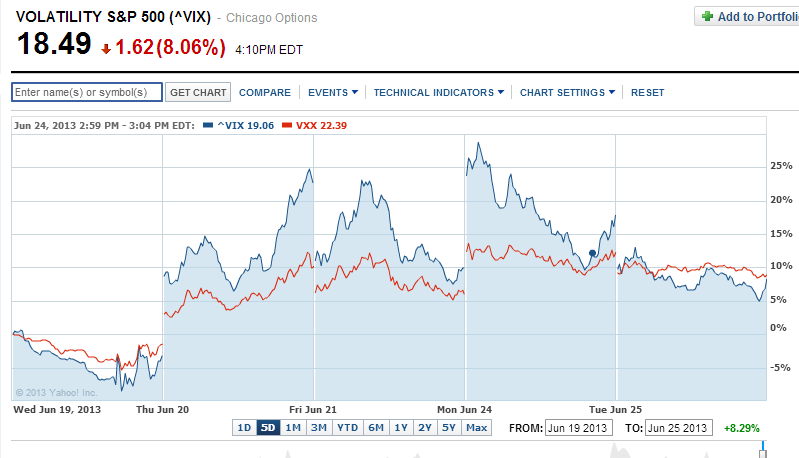As the VIX fell as low as 17.85 today, the futures were not convinced and held a large spread to spot, at times nearly 8%. But at the close, the VIX reclaimed 18 and settled at nearly 18.5, which is 5.5% lower than the July future.
| Symbol | Contract | Month | Time | Last | Change | Open | High | Low |
|---|---|---|---|---|---|---|---|---|
| VX N3-CF | S&P 500 VOLATILITY | July2013 | 16:15:00 | 19.45 | -0.70 | 19.65 | 19.85 | 19.20 |
| VX Q3-CF | S&P 500 VOLATILITY | August2013 | 16:28:45 | 19.95 | -0.35 | 19.85 | 20.15 | 19.60 |
| VX U3-CF | S&P 500 VOLATILITY | September2013 | 16:15:00 | 20.55 | -0.30 | 20.50 | 20.70 | 20.05 |
The futures expect more volatility this summer than the implied volatility in the SPX options suggest:
VIX Volatility Index values generated at:Â Â 06/25/2013 15:14:51
| Trade Date | Expiration Date | VIX | Contract Month |
| 6/25/2013 3:14:51 PM | 18.26 | 1 | |
| 6/25/2013 3:14:51 PM | 18.81 | 2 | |
| 6/25/2013 3:14:51 PM | 19.54 | 3 |
I’ve been conjecturing for some time that the SPX options are not pricing in the true implied volatility in the market for two reasons. First, the growing use of weekly options offer better short-term protection as you are paying less premium, and you essentially receive more gamma. Second, the use of etf options like the FAZ, TZA, IWM and VXX are masking the true demand for put protection and downside trading.
This I believe has been happening for some time, as during the Euro crisis, the financials were where you could get massive downside volatility. Why own SPX options when you can target the weak spot in the market rather effectively? The XLF and FAZ are trading nearly the options volume of the SPX. I am very interested in reading thoughts anyone has on this.
If you look at what the CBOE offers for volatility indexes, there seems to be a gaping hole in measuring where folks actually go for downside vol.
http://www.cboe.com/micro/volatility/introduction.aspx
The RUT options traded 50k contracts today versus the IWM which traded 500k. The SPX traded 800k contracts while the FAZ and XLF both traded 500k.
Back to the VXX, this chart really tells you how the VIX and VIX futures have behaved during the sell-off. The futures have been far less volatile than the actual index options. In other words, the VVIX or the volatility of the VIX has been higher than the VIX futures:
What can happen here if things calm down in the equities markets, is that the VXX could drop by more than 10% in a very short period of time. If the VIX futures fall to 17, that would be a 13+% drop in the VXX to 19.50 or so. That is why I like the VXX puts for July expiration. Interestingly today, as the VXX fell, the July puts saw their implied volatility fall with it, thus the falling vega outweighed the delta of the options. Yet, the delta will catch up quickly if the VXX experiences one of it’s trademark 7-10% down days.
Also keep in mind that the VXX now has higher expectations for volatility than the index options do, and a rise in the VIX will not move the VXX much higher. The risk is clearly to the downside. But if the S&P wants to resume a trip to the 200 day moving average, then the VXX will obviously hang tough.
